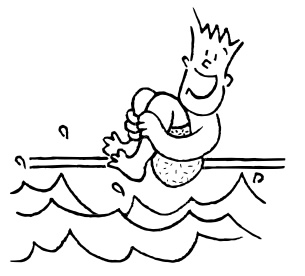Because we care about your health and safety, Maryland Primary Care Physicians has put together this list of tips to help your family enjoy a healthy and safe summer.

Tip #1: Beware of the Sun
Studies show that more than a million cases of skin cancer are diagnosed each year, and that even a few serious sunburns can increase your risk of getting skin cancer. You can protect yourself during the time of day when the sun’s UV (ultraviolet) rays are strongest — between 10:00 a.m. and 4:00 p.m. — by wearing long sleeves and pants, and by applying sunscreen with UVA & UVB protection and an SPF of 30 or higher. The American Cancer Society recommends that children wear a waterproof sunscreen with an SPF of 30 or higher and that it be reapplied every 2 hours when at the pool or beach where the sunscreen may wear off quickly.
Tip #2: Prevent Heat-related Illness

Normally, the body has ways of keeping itself cool, by letting heat escape through the skin, and by evaporating sweat (perspiration). If the body does not cool properly, or does not cool enough, a person may suffer a heat-related illness. Anyone can be susceptible although the very young and very old are at greater risk. Heat-related illnesses can become serious or even deadly if unattended.
- Dress for the heat. Wear lightweight, light-colored clothing. It is also a good idea to wear hats or to use an umbrella.
- Drink water. Carry water or juice with you and drink continuously even if you do not feel thirsty. Avoid alcohol and caffeine, which dehydrate the body.
- Eat small meals and eat more often. Avoid foods that are high in protein which increase metabolic heat.
- Slow down. Avoid strenuous activity. If you must do strenuous activity, do it during the coolest part of the day, either early morning or late evening.
- Take regular breaks when engaged in physical activity on warm days. Remember, have fun, but stay cool!
Tip #3: Lawn Mower Safety
Warm weather means there’s lots of lawn mowing to be done! Always take the following precautions to guard against injury:
- Try to use a mower with a safety control that stops the mower if the handle is let go.
- Wear sturdy shoes (not sandals or sneakers) while mowing.
- Prevent injuries from flying objects, such as stones or toys, by picking up objects from the lawn before mowing begins. Have anyone who uses a mower wear hearing and eye protection.
- Children younger than 16 years should not be allowed to use ride-on mowers. Children younger than 12 years should not use walk-behind mowers.

Tip #4: Bike Safety
While bike riding is a staple of summer for many, it can lead to severe injury for those who aren’t careful. Some rules for bike safety are:
- Always wear a bicycle helmet. The most serious bike injuries are a result of head injury.
- Follow all traffic rules (bikes have to follow the same traffic rules and signs as cars), wear bright colors or clothes that reflect light at night so drivers can see you.
- Also, get a headlight for the front of your bike and reflectors on the front and back of your bike if you ride at night. Wearing a helmet also applies for activities such as skateboarding or rollerblading.
Tip #5: Outdoor Food Safety
 No matter what time of the year, more and more people are cooking outdoors. But outdoor barbeques and picnics during the summer pose a few extra challenges. Protect yourself and your friends and family in these ways:
No matter what time of the year, more and more people are cooking outdoors. But outdoor barbeques and picnics during the summer pose a few extra challenges. Protect yourself and your friends and family in these ways:
- Keep perishable food cool on longer trips; place it in a cooler with ice or freezer packs. Put raw meat/poultry in a plastic bag so juices won’t cross-contaminate your fruits or vegetables.
- Don’t keep food out in the heat; perishable food sitting outside for more than 2 hours is not safe.
- To prevent food borne illness, don’t use the same utensils or platters for raw and cooked meats, and be sure to keep food surfaces clean.
Tip #6: Keep a First Aid Kit with you in your Home, Car and Boat
Stay safe this summer. Make sure to have first aid supplies on hand at home, in your car and when you travel. Here is a list of the key items to include in a family first aid kit from the American Red Cross.
Click here for a printable version of the Summer Health Tips.
50 Board Certified Doctors • 10 Convenient Locations • 1 Smart Choice
 The northeastern United States is a prevalent area for the disease, with over 20% of ticks affected. Lyme disease is most frequently seen in the summertime; and you do not have to go camping or hike in the woods to contract the disease; even gardening can expose you to the organism.
The northeastern United States is a prevalent area for the disease, with over 20% of ticks affected. Lyme disease is most frequently seen in the summertime; and you do not have to go camping or hike in the woods to contract the disease; even gardening can expose you to the organism.





 No matter what time of the year, more and more people are cooking outdoors. But outdoor barbeques and picnics during the summer pose a few extra challenges. Protect yourself and your friends and family in these ways:
No matter what time of the year, more and more people are cooking outdoors. But outdoor barbeques and picnics during the summer pose a few extra challenges. Protect yourself and your friends and family in these ways:


